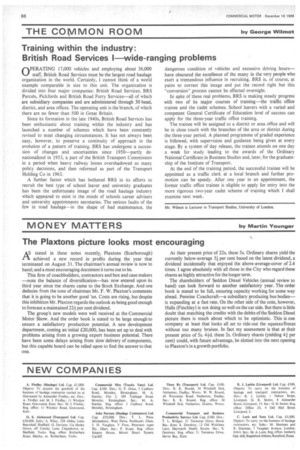THE COMMON ROOM
Page 68

If you've noticed an error in this article please click here to report it so we can fix it.
by George Wilmot
Training within the industry: British Road Services l—wide-ranging problems
OPERATING 17,000 vehicles and employing about 36,000 staff, British Road Services must be the largest road haulage organization in the world. Certainly, I cannot think of a world example comparable in size to this unit. The organization is divided into four major companies; British Road Services, BRS Parcels, Pickfords and British Road Ferry Services—all of which are subsidiary companies and are administered through 30 head, district, and area offices. The operating unit is the branch, of which there are no fewer than 500 in Great Britain.
Since its formation in the late 1940s, British Road Services has been enthusiastic about training within the industry and has launched a number of schemes which have been constantly revised to meet changing circumstances. It has not always been easy, however, to preserve a continuity of approach in the evolution of a pattern of training. BRS has undergone a succession of changes and uncertainties since 1950—partly denationalized in 1953, a part of the British Transport Commission in a period when heavy railway losses overshadowed so many policy decisions, and then reformed as part of the Transport Holding Co in 1963.
A further factor which has bothered BRS in its efforts to recruit the best type of school leaver and university graduates has been the unfortunate image of the road haulage industry Which appeared to exist in the minds of schools career advisers and university appointments secretaries. The serious faults of the few in road haulage—in the shape of bad maintenance, the dangerous condition of vehicles and excessive driving hours— have obscured the excellence of the many in the very people who exert a tremendous influence in recruiting. BRS is, of course, at pains to correct this image and put the record right but this "conversion" process cannot be effected overnight.
In spite of these real problems, BRS is making steady progress with two of its major courses of training—the traffic office trainee and the cadet schemes. School leavers with a varied and competent General Certificate of Education level of success can apply for the three-year traffic office training.
The trainee will be assigned to a district or area office and will be in close touch with the branches of the area or district during the. three-year period. A planned programme of graded experience is followed, with supervision and guidance being given at every stage. By a system of day release, the trainee attends on one day a week for study leading to the awards of the Ordinary National Certificate in Business Studies and, later, for the graduate ship of the Institute of Transport.
At the end of the training period, the successful trainee will be appointed as a traffic clerk at a local branch and further promotion can be speedy. After one year in an appointment, the former traffic office trainee is eligible to apply for entry into the more rigorous two-year cadet scheme of training which I shall examine next week.
Mr. Wilmot is Lecturer in Transport Studies, University of London.




























































































































